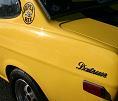In the war - generally the additive was in fact 50/50 water methanol. Baz is spot on about the difference between water and methanol and the reasons for each being useful etc.
If you could be bothered, there's some test data available from NACA archives
http://naca.central.cranfield.ac.uk/(NACA was effectively the predecessor to NASA and they pretty much tested/researched anything you care to name regarding planes. There's actually some fascinating stuff to read there - some of the very early articles, about material and starches (or stuff that acted like starch - usually called 'dope' but that name is probably associated with drug slang these days!) for wing and even fuselage coverng. They also have some data on water injection.
They tested and found gains (either in max available boost, or power output, and of note, you can get to a point that although you run more boost, the energy taken to make it starts to negate the gains, esp given the amt of water required to keep it safe. Ironically on modern supercharged piston engined race planes, which still utilise some stuff that dates back to the ww2 era they get to a point where more boost doesn't = more power but they are still faster - believe it or not, the increase in speed is from thrust generated from the short, but curved and rearward opening exhaust tubes!). Anyway NACA tested this stuff and they were finding more gains even up to and slightly over a 1:1 ratio - by which I mean they were injecting as much water as the entire fuel supply (not just 1:1 ratio of water/meth, if it took 30kg of fuel to supply the entire power needs for say 2 minutes, they have run up to and over 30kg water through in the same period). Most water injection setups for cars (admittedly less boost and smaller engines etc) would likely run up around 10-25% maximum added water vs fuel needs. They DID however also see enough oil contamination when water %ages were high, so it's got to be kept more reasonable for a streeter (or if massive rates, change oil after each race meet).
The other interesting thing, since water is essentially free beyond initial injection equipment costs, is that running way rich mixtures helps hold off preignition and detonation, well that effect comes solely from teh extra fuel having a cooling effect. So if you wanted, and never ran it out of water, you can actually run leaner mixtures than you normally would for a turbo setup, and use water injection to replace most of the enrichment fuel and get the same power a little cheaper. You still have to stay richer than stoich for max power even with that hypothetical scenario - not so much for safety of a richer mixture, but because it's unlikely all the fuel particles would be ideally placed to combust with the oxygen around them, so you need a little bit of a surplus of fuel so that each and every oxygen atom is utilised.
Andf to round it off, I accidentally found this (was searching for something else entirely) on youtube
http://www.youtube.com/watch?v=qGZeDrf-5Kk&feature=relatedIt explains what is needed to make an lpg setup run in blowthrough configuration - yep - just one added hose connecting pre-mixer boost levels to the other side of the main convertor diaphragm. I could probably argue that there are better lpg systems out there that I would have chosen over that example, but the principle, and inherent simplicity of it is the same!









 Transfer
Transfer






